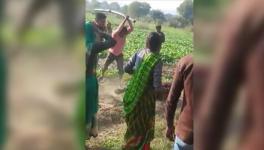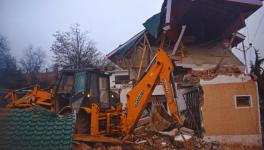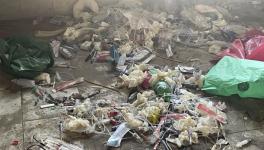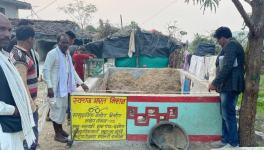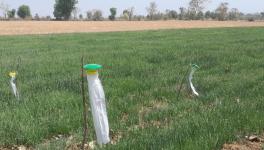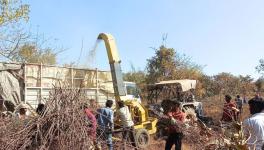Villages of Widows in Madhya Pradesh’s Panna District
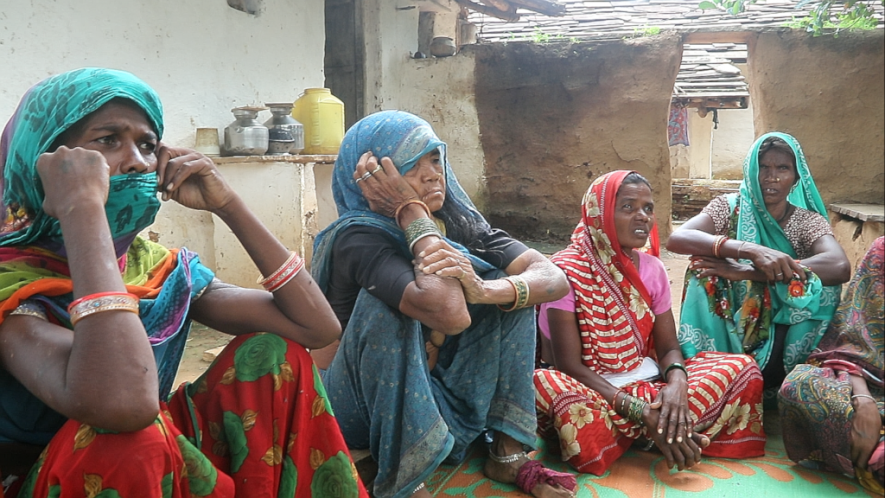
Photos by Kashif Kakvi
Panna: In the extreme summer heat, 35-year-old Mithali Adiwasi of Manjha village is seated outside her mud house, cleaning lice from her four-year-old daughter’s hair. A mother of two girls, Mithali is worried how to feed them.
Early in the morning, she had gone to Panna – which is 5 km away from her village – to look for work, but had to return empty-handed as no one hired her.
Mithali used to work in a stone mining quarry and was paid Rs 180 as daily wage, but mining activities have stopped since a fortnight due to the rains. She is somehow eking out a living. As she doesn’t have any other skill, the only option for her to feed her children is to work as a labourer. However, even that has been hard to get, especially with the economic slump gripping the entire country.
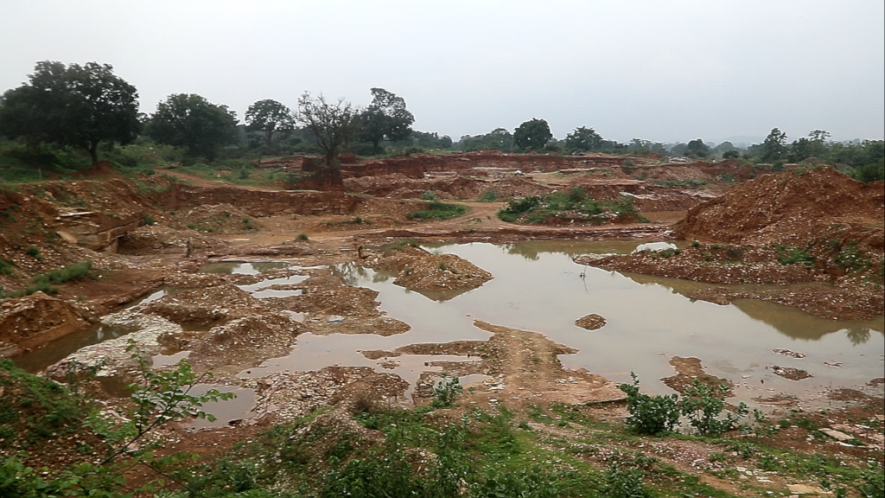
Stone Mine, Manjha.
Mithali's husband, Gyasi Adivasi, allegedly died of silicosis last year. They used to work together. “Some villagers say he died of silicosis while some say of TB. But, my life has turned into hell since he departed at such a young age leaving two daughters behind,” she said, adding that, he was vomiting blood during his last days.
“Since childhood, Gyasi had been working in the stone mining quarries of Panna and thus suffered from silicosis at a very early age. After an initial check-up, doctors confirmed tuberculosis (TB) and asked him to use DOTS medicine to get rid of the disease,” said her 65-year-old neighbour, Rajkumari.
A health camp, organised by an NGO in 2017 in the city, identified Gyasi as silicosis positive. But it was too late to treat him, He died the following year. “The DOTS medicine didn’t work even after five years of constant treatment. He was suffering from silicosis and government doctors were terming it as TB,” Mithila said. Gyasi died at the young age of 39.
Mithali is not the only one in Manjha village who has lost her husband to silicosis. Several people have died due to continued exposure to silica dust, which has gone unreported.
Also watch: Silicosis Deaths in MP: Fatal Disease Overlooked by Govt for Years
Silicosis is a lung disease caused by breathing in tiny bits of silica, a mineral that is part of sand, rock, and mineral ores such as quartz. It mostly affects workers exposed to silica dust in occupations such as mining, glass manufacturing, and foundry work.
Manjha, located on the outskirts of Panna city, falls under the Delan Chowki panchayat. There are more than 200 families in the village who have been living on government land for the last 15 years. Almost no one has a permanent structure or a furnished home, and live in mud houses with thatched roofs. The residents of the village are mostly tribals.
Besides silicosis, the village also has nearly half dozen cases of malnutrition.
When NewsClick visited Manjha, a shocking revelation awaited us -- the village has hardly any men. On being asked for the reason behind this, 65-year-old Kalyan Singh Yadav, a resident of the village, said most of the men died of silicosis, and those who survived, had migrated to other cities for jobs. “Only women and children live here and those men who are ill and old,” he said.
Silicosis patients at Panna District Hospital.
Kalyan Singh has been a silicosis patient for the last 15 years, but has survived because he quit the mining job. “I’m alive because I quit stone mining and started driving after the doctors informed me about my having TB and the chance of silicosis being high. My friends and fellow labourers who did not quit stone mining, have died as early as 40-45 years old.”
Saraswati, who was standing close to Kalyan Singh, told NewsClick, “My husband Keshu is also a silicosis patient. He used to do stone mining and now he is vomiting blood. He is only 34 years old. With the help of an NGO, we identified the disease and they are helping in his treatment.”
After a long fight between the NGO Prithvi Trust and the state Health Department officials, Saraswati’s husband was accepted as a silicosis patient. Now, he is under treatment in the government hospital in Nowgaon.
When NewsClick asked them why they work in the stone mining quarries – despite knowing that it causes silicosis – instead of seeking jobs under Mahatma Gandhi National Rural Employment Guarantee Scheme (MGNREGS), one of the women said, “Initially we used to get 60-70 days work, but even that has shrunk to 20-30 days now. Besides, the contractors don't pay the wages for weeks. We have nothing else to do except work in the mines."
According to data available on the MGNEREGA website, a total of Rs 40 crore is still unpaid to the labourers in Panna district itself.
Silicosis has assumed epidemic proportions here, claiming the lives of the men from several villages, leaving their widows behind. Village after village, one can hardly find any men.
The condition is almost similar in Badore and Raniganj village which is 5 to 15 km away from the city. “Every third woman in these villages is a widow, after their husbands died at very young age due to silicosis,” said asocial activist Chhatrasal Patel.
Women of Badore village.
According to the data available on the MGNREGA website, Panna is home to 1.4 lakh labourers. Of them, less than 2% are skilled. The district has dozens of legal and illegal stone and diamond mines where thousands of labourers work everyday.
Also read: Diamond Mining in Panna: Illegal Excavations and Inconspicuous Auctions
According to a social activist Yousuf Beg, who runs the NGO Prithvi Trust in Panna and has been fighting for silicosis patients for a decade, “Panna has thousands of silicosis patients, but the state health department never take the pain to carry out a survey or organise a health camp to identify and treat them. Not only that, the department had even refused to acknowledge the existence of any such disease here.”
Beg claimed that they had identified 172 silicosis patients in a day-long health camp and handed over the report with names to the Health Department and the National Human Rights Commission. Only after that the department agreed to the existence of silicosis.
“There are many villages like Manjha, which have turned into a village of widows just because of silicosis. Urgent attention of the state government is needed, otherwise, this disease will claim thousands of life every year,” he added.
R Sreedhar, a Delhi-based social activist, who has worked with silicosis patients across Madhya Pradesh, said, “It’s an epidemic, which was largely undermined by the state governments. Approximately, there are more than 2 lakh silicosis patients in the state.”
Sreedhar's NGO, Environic Trust has organised multiple health camps in Vidisha, Panna, Bhind and other pockets of the state between 2011 to 2017 to bring the extent of the disease to the government's notice.
Also read: No Development, No Employment: Panna Tiger Reserve Is a Curse, Residents Claim
When contacted, the district magistrate of Panna, Karamveer Sharma said, “We are trying to carry out a survey to identify the silicosis patients and give them all possible help.” He added, “In the recent meeting with the department officials, I urged them to give priority to the silicosis patients in government schemes.”
Get the latest reports & analysis with people's perspective on Protests, movements & deep analytical videos, discussions of the current affairs in your Telegram app. Subscribe to NewsClick's Telegram channel & get Real-Time updates on stories, as they get published on our website.










